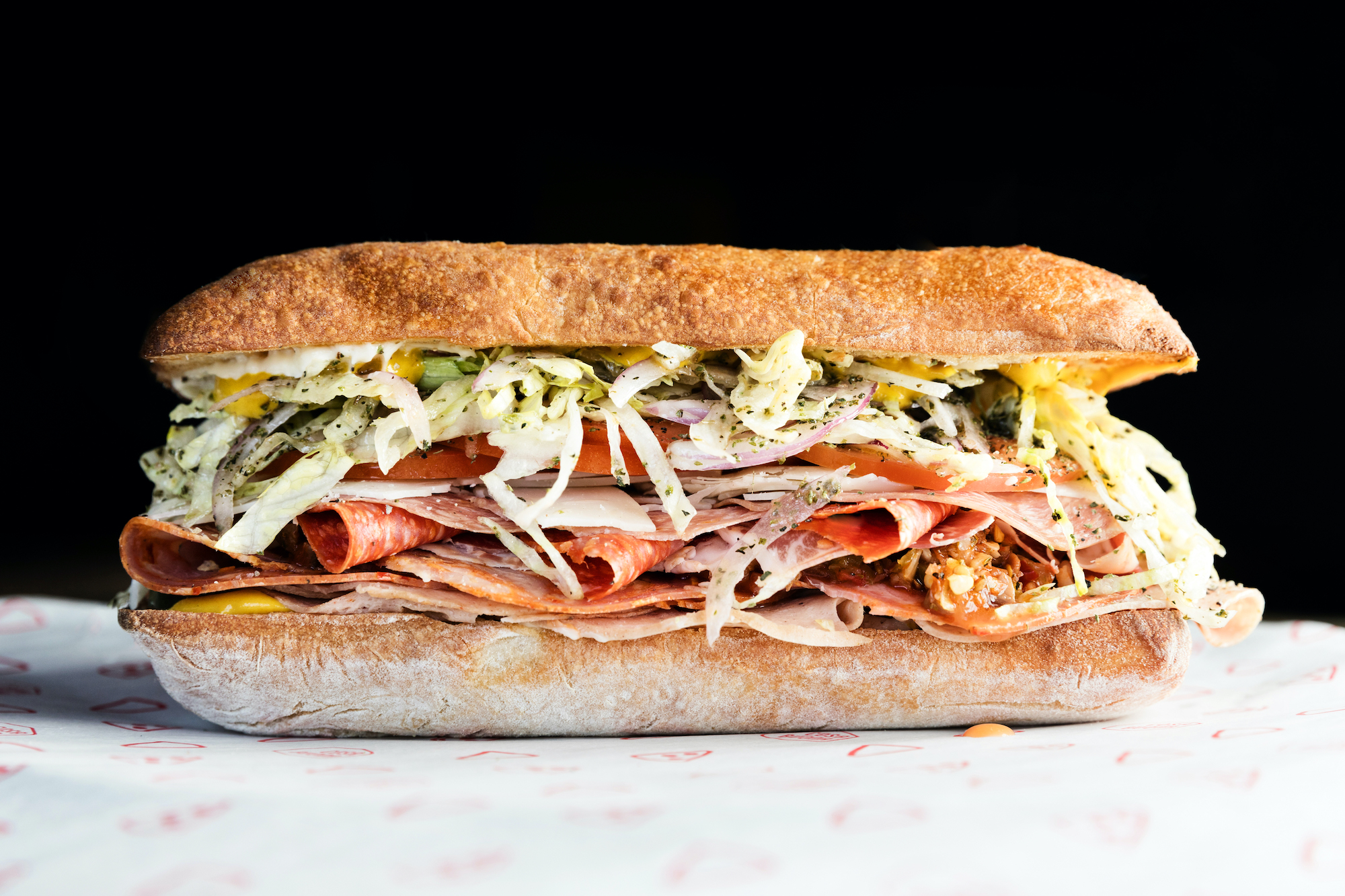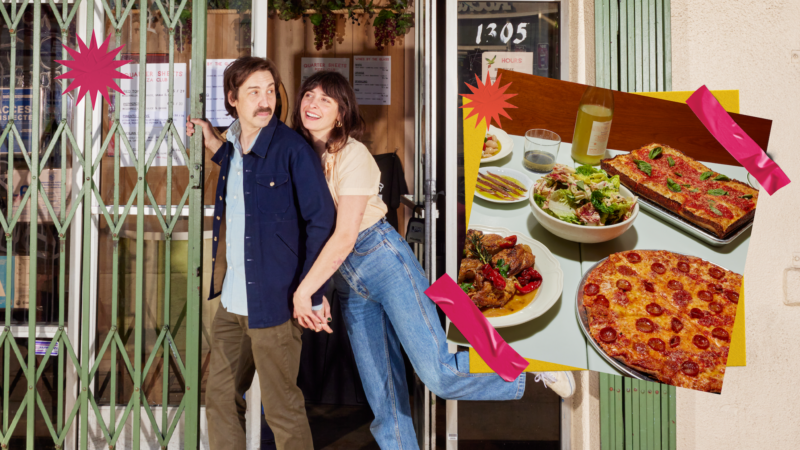
Cosa Buona’s Twists on Italian-American Classics, As Seen Through Five Dishes
Zach Pollack knew he’d come back to pizza someday, but he had no idea he’d switch from artisanal crusts to CPK-inspired barbecue chicken pies at Cosa Buona.
The born-and-bred Angeleno first fell in love with making pizza while working at Pizzeria Ortica in Orange County, and several years later, he opened Sotto with fellow Ortica chef Steve Samson. The intimate, ambitious restaurant near Century City quickly became known for its Neapolitan-style pizzas baked in a hand-crafted, white oak-fueled, Italian stone oven.
Ringed in airy, leopard-spotted cornicione (crust), the pizzas were legendary. Pollack and Samson were part of the wave of game-changers that helped make the phrase “great L.A. pizza” less of a joke made by East Coast expatriates and more of a delicious reality.
After stepping away from his daily duties at the blistering, 15,000-pound Stefano Ferrara pizza oven, the young chef debuted his own more personal Italian restaurant, Alimento, in Silver Lake. Here he created dishes inspired by his time studying in Florence and traveling all around Italy, coupled with his upbringing in Southern California. The menu featured things like fusilli and clams in smoked butter, buttermilk-brined Milanese, and saffron risotto tots.
But like La Cosa Nostra to an older, wiser Michael Corleone, pizza kept pulling him back in.
“Because there is something uniquely joyous about it for me. I knew I’d have to weave pizza back into my life,” the chef says.
When Pollack spotted the impending closure of Echo Park’s 50-year-old location of Pizza Buona in 2016, he jumped on the opportunity to open his own version of a casual Italian-American restaurant that all but defied the ultra-precise, provincial cuisine for which he had become famous.
No mere approximation of a red-sauce joint, Cosa Buona is determined to elevate comfort food classics that are deeply etched into our country’s collective palate. Pollack’s dishes blend clever nods to familiar favorites, both homegrown and imported, in abundance.
Everything seems simple, but that’s the beauty: it’s not. The pies are wood-fired and topped with meticulously sourced ingredients. The mozzarella sticks are feted by strenuous R&D and ooze with smoked cheese. Ranch dressing, wing sauce, and sub sandwich breads are all made in-house to the chef’s high standards.
“Most of Cosa is in the craft, rather than trying to reinvent a dish or reimagine it,” Pollack says. “We’re just trying to hone in on the best version of it.”
Here the chef recounts inspiration for some of his favorite dishes on the Cosa Buona menu, and how they speak to everything he wants the restaurant to be.


Eggplant Parm
“I like eggplant Parm and wanted to have a substantial vegetarian option [on the menu]. I borrowed the idea, and not from anything related to Italian food. It was actually Judy Rogers and The Zuni Café Cookbook. One of my favorite recipes in there — it’s probably my favorite cookbook — the panades that she does where you layer vegetables, cheese, and stale bread and then you bake it forever. And I was like, ‘well, eggplant Parm is cheese and bread and vegetables,’ so what if we took that approach and layered thin slices of all those things, tomato sauce and a little bit of water instead of broth, and we cook it overnight? And I think it comes out wonderfully. It hits all the familiar flavor notes of what an eggplant Parm should taste like but it’s a different expression, and not fried.”


The Stepmother
“This is the sub inspired by The Godmother at Bay Cities, the iconic Italian sandwich of Los Angeles. I grew up in Westwood with a lot of friends in Santa Monica and the Palisades. We would go to Bay Cities and someone always had Bay Cities sandwiches in the house. And my parents each had several marriages, so I’ve had my share of stepmothers growing up. I just thought it was kind of a funny play.
“We definitely ate a lot of the sandwiches at Bay Cities. We didn’t want to plagiarize directly, we wanted to make it our own. So, we make the bread in house. We had been sourcing it, but really didn’t love them. We found one and were like, ‘Ok, this is pretty good.’ On the second delivery, it showed up and there was mold on it. I said, ‘screw this.’ And we’ve been making it ever since.
“Ours has iceberg, yellow mustard, tomatoes, pickles, a little bit of heat from Calabrian chiles mixed in with the giardiniera. It needs giardiniera. There is Olympia Provisions mortadella, capicola, I think from Smoking Goose, San Daniele prosciutto, and two types of salami, Molinari fennel salami and a spicy salami, I forget where that’s from at the moment, and also provolone imported from Rome.
“It wouldn’t be my first inclination to use yellow mustard. I tried it with Dijon. Wasn’t a thing. I tried it with spicy mustard. No. It needs f—ing yellow mustard. It’s a totally different sandwich without it. Take off the mayo? No. It needs the mayo. The biggest revelation on that one was iceberg lettuce. Until I started messing around with the sandwich and the chopped salad, I had no affection for iceberg whatsoever. And it was only when I was looking at all the sandwiches, saying, ‘what is this missing?’ You know, we’re using Little Gems, and they have sweetness and crunch and they’re heartier, but it just wasn’t the same. Once we throw in iceberg, it was a game-changer.”


Smoky Mozzarella Sticks
“The mozzarella sticks are our best seller and really encapsulate what Cosa is about: comforting, familiar food executed with as much attention to the craft as possible with the best ingredients we can find. It was so based on these certain kinds of [Italian-American] restaurants where the menu almost wrote itself. Obviously, we have to have mozzarella sticks. So, it was like, let’s talk to the purveyors and find the best cheeses. Let’s look at how we’re going to fry them, what we’re going to fry them in, what temperature we’re going to fry them at, what we’re going to bread them with, what’s going to be in the breading, and all that jazz.
“We relentlessly sourced the mozzarella, ‘cuz obviously that’s number one, and the tomatoes for the tomato sauce. We ended up finding really great examples of both. It’s a smoked mozzarella from the East Coast. I find the creameries out there, there’s more of that culture. Whereas the West Coast tends to make more traditional Italian cheeses, like less brick cheese, and more like fresh mozzarella or low-moisture, Polly-O types. These are a little more milk-focused and less, like, salty, and have less of that je ne sais quoi. However, Covid just killed our cheese supply, so we’re now looking for new cheese. But the warehouse has a lot stocked so we’re good for the time being.
“For the sticks, it’s important to get the dimensions and temperature right. The right ratio of cheese-to-breading. So we were toggling the dial on the slicer down to prosciutto dimensions; hopefully that slicer never dies. The sticks themselves, rather than use a classic egg wash, we use a different batter. I can’t tell you the exact recipe for that, but it adheres really well and encapsulates everything inside. So even if a few breadcrumbs fall off a little part, there’s still a crispy batter right there to back it up.”


Chicken Wings
“They’re one of my favorite things on the menu. Wings are definitely not Italian and they’re not even Italian-American, and yet, they kind of wove their way into being a thing that you would have on a menu with mozzarella sticks. It maybe doesn’t fit neatly into the Italian-American box, but it does fit neatly into the ‘I want to order pizza, what are my options on the side’ box.
“The first iteration is the chile pork ribs at Alimento, which uses the same sauce. We use honey, Calabrian chiles, vinegar, butter, and things that are traditional and things that are not, but the overall effect is that it really hits that familiar [taste]. It just smacks of Frank’s Red Hot, even though it tastes a little different. So, we call the sauce ‘Zach’s Red Hot.’
“We cook them three times. It’s kind of inspired by the thrice-cooked French fry method, where they’re steamed and twice fried. There’s no breading or dredge, it’s just naked wings dropped into the fryer and subsequently tossed in that there Zach’s Red Hot and a gorgonzola dip on the side.”


BBQ Chicken Pizza
“I wanted to have this on the menu. It was something I grew up eating and I believe it was probably invented in Los Angeles. There was a guy in the Valley that claimed he did it first, at Caioti Pizza Café. But obviously it got famous when Wolfgang Puck started doing it. There was even a Wolfgang Puck frozen version and growing up, we had a few of those in our freezer at all times. It was also one of my favorite pizzas to eat at California Pizza Kitchen. I probably ordered it more than the others. I don’t know if it’s the combination that masked other imperfections in the CPK dough or whatever, but it was good. I haven’t had it in a couple of decades, but I should go back, that’s really negligent of me. Again, it was, ‘this is something I like to eat, let’s make a version that’s great. Better than maybe the versions we grew up eating.’
“We brine the chicken, steam it and slice it thinly, so you’re getting more coverage as opposed to big chunks that roll around when you pick up a slice. We’re making our own barbecue sauce, with dried chiles and certain things that still taste like a sweet, wonderful barbecue sauce. The objective is something kind of along the lines of McDonald’s barbecue sauce, without like, the corn syrup taste and all of that overwhelming sweetness. Not something where you’re like ‘oh, I taste the guajillo chile in that, or the smoked chipotle.’ Just trying to make a really great version that hits on the acidity. We use distilled vinegar, which, 10 years ago, I used to scrub floors and not for cooking. But like the iceberg or yellow mustard, there are a lot of applications for distilled vinegar where red wine vinegar or white wine vinegar or apple cider vinegar just doesn’t cut it.
“For the dough, we use a flour with higher gluten that is a little stronger, and we cook it at a lower temperature, so the combination of those things results in something that’s still pliable and has a nice chew but not quite as supple and pastry-like as a really traditional Neapolitan pie. The toppings, we also have some of the traditional ones, like a marinara and margherita, but we certainly venture into more Americana/Italian-American toppings with the bulk of the menu at Cosa.
“We use the same oven [as Sotto]. Sotto’s was built on site, but they’re pretty similar. We still have that puffy cornicione. I can’t really imagine not having that. For me, it’s like the palate cleanser at the end of the slice, delicious, simple, dip it in some ranch, whatever you want.
“You have the housemade barbecue sauce, the chicken that’s been treated nicely, and cut in a way that heats better on top of the pizza, the cheese, the raw red onion, two kinds of chiles, cilantro, jalapeño, and our housemade ranch on top. And it just fires.”
Hadley Tomicki is an L.A.-based writer on food, travel and culture, and the co-founder of the James Beard Award-winning website L.A. Taco. Follow him on Instagram. Follow Resy, too.
















